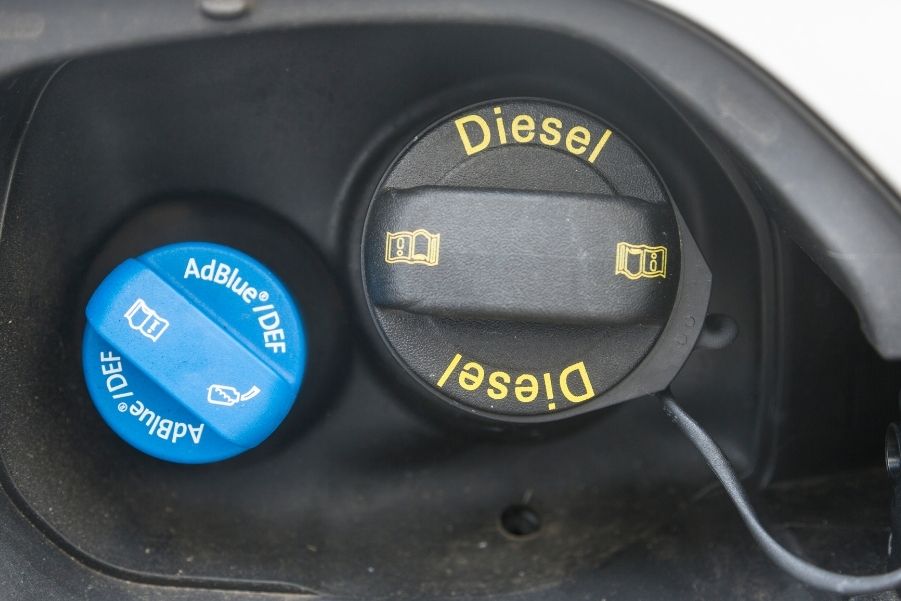AdBlue is a diesel exhaust fluid that helps reduce harmful emissions. We explain how it works and what you need to know
Open the fuel filler flap of a modern diesel car and you’ll notice there are two screw caps – the normal fuel filler and a bright blue cap with AdBlue written on it. But what is AdBlue and why is it so important? We explain all, and bust a few myths in the process.
What is AdBlue and why do I need to use it?
AdBlue is a diesel exhaust fluid that mixes with the fumes your engine creates to reduce the amount of air pollution your diesel engine produces. The aim of AdBlue is to reduce harmful nitrogen oxide (NOx) emissions from diesel engines. Carmakers have to comply with strict European rules about emissions, called the Euro 6 standard, and AdBlue is one of the ways that manufacturers meet these targets.
AdBlue is injected into the exhaust system to break down the NOx particulates, in a process called Selective Catalytic Reduction, or SCR. But we won’t go into detail about that. Science happens and your harmful exhaust emissions are reduced.
What is AdBlue made of?
There’s a rumour that AdBlue is just pig wee, but that’s not really the case. AdBlue is made of urea, a substance found in urine, and deionised water. All AdBlue is made to an international standard (32.5% urea and 67.5% deionised water), so there’s no difference between brands or supermarket AdBlue.
Wherever you get your AdBlue from, you’ll get a colourless, odourless and non-flammable liquid – so it won’t smell like you’re weeing in your tank when you fill it up. It does sometimes dry as a white flaky material though, so don’t spill it on your shoes. Ask us how we found that out.
Which cars need AdBlue?
Diesel cars registered after September 2015 require AdBlue. If you own a Euro 6 compliant vehicle, it is highly likely that you will need to use AdBlue.
If you are unsure whether your car needs AdBlue, the engine name will usually contain the word ‘Blue’ – like Ford EcoBlue and Peugeot BlueHDi engines. The handbook should also state whether it needs AdBlue.
How do I fill up with AdBlue and how often?
Your AdBlue tank will be topped up at routine services, but you might also have to top it up yourself in between. You simply pour the AdBlue from the container into the tank. Some AdBlue containers have a funnel or a tube so that you might be able to avoid pouring it all over your feet.
How often you fill your car with AdBlue can depend on your driving style, the size of your tank and the number of miles you cover. A 10-litre bottle will usually be enough to get you at least 3,000 miles.
There will be a warning light that appears on your dashboard to let you know when you are running low and it's time to top up. Once you have topped your vehicle back up, this will trigger the sensor to let the car know it is at an adequate level and the light will disappear from your dashboard.
What happens if I run out of AdBlue?
You’ll get plenty of dashboard warnings when your AdBlue level is low, because the engine is designed to run with AdBlue dosing. If you ignore the warnings and run out of AdBlue, your power and performance will be limited until you top up again.
If you’re completely out of AdBlue, your car won’t start. So if you are running low, make sure to top up your tank to avoid the inconvenience of a breakdown.

Can I water down AdBlue to save money?
It is important that you never add water to your AdBlue. The mix is specifically calculated to reduce emissions, and you could cause engine damage if you add water into the AdBlue tank.
Misfuelling diesel and petrol vehicles is quite a common mistake to make at fuel stations, so you can’t ever rule out inserting AdBlue into your diesel fuel tank if you are ever in a rush or not fully concentrating. If this does happen, you must not start your engine and contact a breakdown/recovery agent immediately. They will need to flush out the system to make sure no damage is done to any of the vehicle’s components.
Where can I buy AdBlue from?
If you do need to top AdBlue up yourself in between routine servicing, it can be purchased at most fuel stations – so you can pick some up the next time you are filling up with diesel.
Failing that, online retailers, auto parts stores, garages and even some supermarkets will stock it.
AdBlue bottles come in a variety of different sizes, so you could even purchase a smaller 1.5L container to keep in your car in case of an emergency. Really, though, you get enough warning that you’ll be able to go somewhere to buy some more.


































